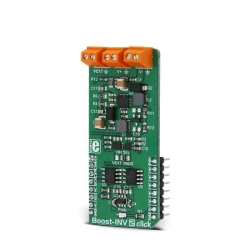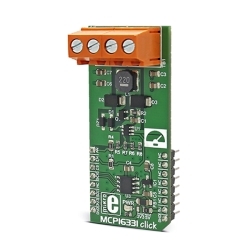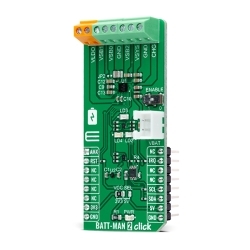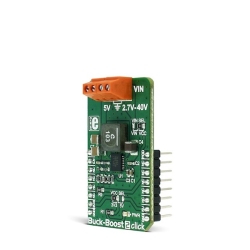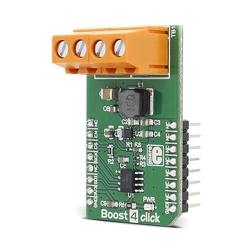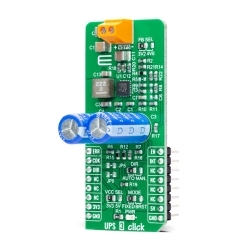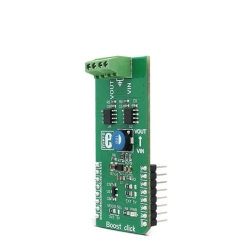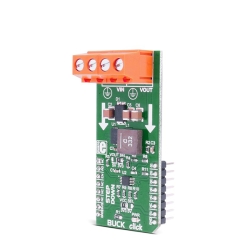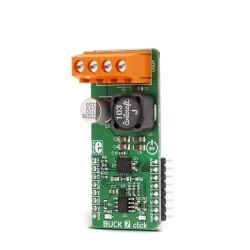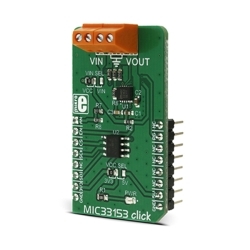MIKROE Buck-Boost Click
Buck-Boost Click is a compact add-on board that contains a buck-boost DC/DC converter.
Product Overview
Buck-Boost Click is a compact add-on board that contains a buck-boost DC/DC converter. This board features the LTC3129-1, a high-efficiency 200mA buck-boost DC/DC converter with a broad VIN and VOUT range from Analog Devices. It supports a wide input voltage range and can output eight discrete regulated output voltage levels, selectable by the digital output voltage selection pins, ranging from 2.5V to 15V. Also, has very low noise and low ripple at the output, as well as very high regulating efficiency and low quiescent current. This Click board™ has many features that make it an excellent choice for the regulators and post-regulators for harvested energy, solar panel post-regulators/chargers, rechargeable battery output voltage regulators, wireless low noise applications, and similar.
Buck-Boost Click is supported by a mikroSDK compliant library, which includes functions that simplify software development.
Buck-Boost Click is based on the LTC3129-1, a 1.3μA quiescent current, monolithic, current mode, buck-boost DC/DC converter that can operate over a wide input voltage range of 1.92V to 15V and provide up to 200mA to the load from Analog Devices. The LTC3129-1 is characterized by its very low noise and low ripple level at the output, as well as very high regulating efficiency and low quiescent current. Eight fixed, user-programmable output voltages can be selected using the three digital programming pins routed to the INT, AN, and CS pin of the mikroBUS™ socket. A proprietary switch control algorithm allows the Buck-Boost converter to maintain output voltage regulation with input voltages that are above, below, or equal to the output voltage. Transitions between the step-up or step-down operating modes are seamless and free of transients and sub-harmonic switching, making this product ideal for noise-sensitive applications.
Buck-Boost Click possesses two different modes of operation - PWM and Burst Mode, depending on the nature of the application. The PWM mode can be selected by setting the PWM pin of the mikroBUS™ socket to a logic high level and is suitable for working with higher loads connected to the converter output and when the extremely low output noise is required. When the PWM mode is selected, LTC3129-1 has a fixed nominal switching frequency of 1.2MHz using an internally compensated average current mode control loop. In this mode, the ripple and the noise level of the output voltage are minimal.
For high-efficiency operation at light loads, automatic Burst Mode operation can be selected, reducing the quiescent current down to 1.3µA. Burst mode can be chosen if the PWM pin is set to a logic low level. If the connected load is light enough, the converter will remain working in Burst mode, running only when necessary to maintain voltage regulation. Otherwise, the PWM mode will be automatically engaged, providing enough current for the connected load.
This Click board™ completely powers itself from the VIN external power supply terminal. Once the power is applied to the VIN terminal, the circuit also has to be enabled by setting the RUN pin routed to the RST pin of the mikroBUS™ socket to a high logic level. This will power up the converter, which will be indicated by the PWR LED indicator. It also includes additional features such as a power-good output with a Power Good LED indicator labeled as PGOOD that pulls to the ground when FB drops too far below its regulated voltage. This pin also can sink up to the absolute maximum rating of 15mA when set low.
Features & Specs
- Interface: GPIO, PWM
- Compatibility: mikroBUS™
- Dimensions: 42.9 x 25.4mm
- Input Voltage: External
- Input Voltage Range (VIN): Min. 1.92 V, Max. 15 V
- Output Voltage Range (VOUT): Min. 2.425 V, Max. 15.50 V
- Inductor Average Current Limit: Min. 80mA, Typ. 200mA, Max. 350mA
- Operating Temperature Range: Min. -40°C, Max. +125°C
Documentation
Customer Reviews
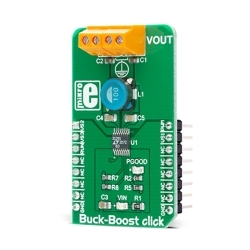
Stock and Customer Discounts
Available Discounts
- $18.95 | 25+ units
- $17.96 | 100+ units



